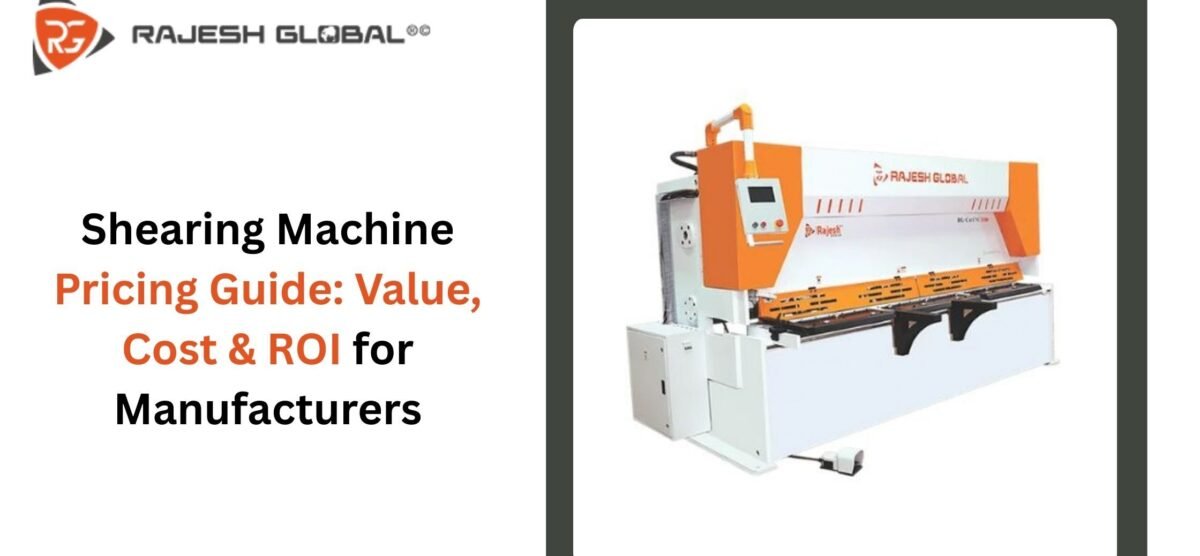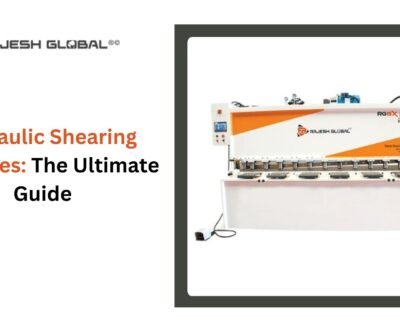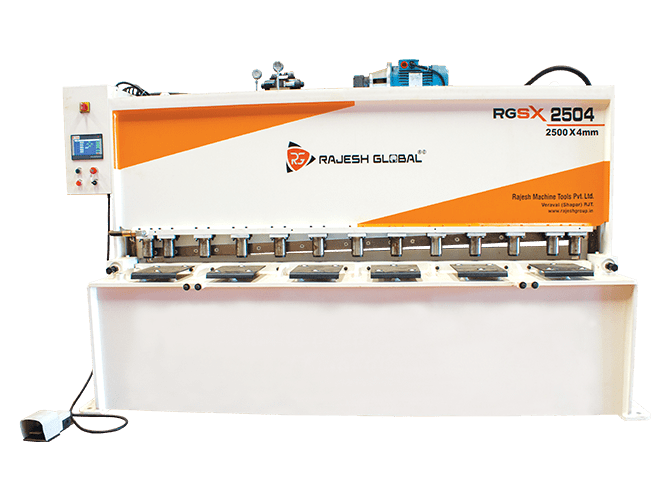Blog

Shearing Machine Pricing Guide 2025: Types, Cost Factors & Market Insights
In today’s competitive manufacturing landscape, every investment must deliver measurable value. For manufacturers, the shearing machine is a cornerstone of productivity, efficiency, and quality. Understanding the full spectrum of costs, value, and return on investment (ROI) is essential for making an informed purchase that powers your growth. As a leader in the field, Rajesh Machine Tools presents this comprehensive guide to demystify shearing machine pricing and help you maximize your investment.
Shearing Machine Types and Their Price Ranges
Contents
- 1 Shearing Machine Types and Their Price Ranges
- 2 Key Factors Influencing Shearing Machine Price
- 3 1. Machine Type & Specifications
- 4 2. Brand Reputation & Quality
- 5 3. Additional Features & Customization
- 6 4. Market & Economic Factors
- 7 Shearing Machine Cost Breakdown
- 8 How to Analyze Shearing Machine Value
- 9 1. Match Machine to Production Needs
- 10 2. Compare Multiple Suppliers
- 11 3. Assess Long-Term Costs
- 12 ROI Analysis: Maximizing Your Investment
- 13 Direct ROI Drivers
- 14 Indirect ROI Benefits
- 15 Shearing Machine Pricing Trends in India
- 16 Common Mistakes to Avoid When Buying a Shearing Machine
- 17 Why Rajesh Machine Tools Delivers Superior Value
- 18 Conclusion: Making the Right Shearing Machine Investment
Shearing machines come in various configurations, each with distinct features and pricing:
| Machine Type | Typical Price Range (INR) | Typical Use Case |
| Manual Hand Shearing Machine | 5,000 – 95,000 | Light-duty, small workshops |
| Treadle Shearing Machine | 60,000 – 1,75,000 | Medium-duty, manual operation |
| Hydraulic Shearing Machine | 1,25,000 – 40,00,000+ | High-capacity, industrial use |
| CNC Hydraulic Shearing Machine | 10,00,000 – 1,50,00,000+ | Automated, high-precision |
Key Insight: Hydraulic and CNC models command higher prices due to advanced features, automation, and superior cutting precision.
Key Factors Influencing Shearing Machine Price
1. Machine Type & Specifications
- Hydraulic vs. Mechanical: Hydraulic machines are more expensive but offer better control, quieter operation, and higher precision.
- Capacity: Machines with higher cutting thickness and longer bed lengths cost more due to robust construction and powerful components.
- Automation: CNC and NC controls, programmable backgauges, and digital displays significantly increase the price but enhance productivity.
2. Brand Reputation & Quality
- Established brands like Rajesh Machine Tools may have higher upfront costs but deliver long-term savings through durability, reliability, and strong after-sales support.
- Machines from lesser-known brands might save money initially but can lead to higher maintenance and downtime costs.
3. Additional Features & Customization
- Safety features, energy-efficient drives, rapid blade change systems, and custom tooling can add to the cost but often justify the investment through improved workflow and reduced risk.
4. Market & Economic Factors
- Fluctuations in steel prices, import duties, and currency rates can influence machine prices across the industry.
Shearing Machine Cost Breakdown
To make an informed decision, consider the total cost of ownership, not just the sticker price:
| Cost Component | Description |
| Initial Purchase Price | Base cost of the machine |
| Installation & Training | Setup, calibration, and operator training |
| Maintenance & Spares | Regular servicing, parts replacement |
| Energy Consumption | Ongoing power costs, especially for hydraulic models |
| Downtime Costs | Losses due to breakdowns or inefficient operations |
| Upgrades & Retrofitting | Future-proofing with automation or safety enhancements |
How to Analyze Shearing Machine Value
1. Match Machine to Production Needs
- Define your material types, thickness, and daily output requirements. Oversizing or undersizing can erode ROI.
- Evaluate if automation features (CNC/NC) are necessary for your production volume and product mix.
2. Compare Multiple Suppliers
- Obtain detailed quotations from at least three suppliers. Compare not only price but also warranty, after-sales service, and spare parts availability.
3. Assess Long-Term Costs
- Factor in energy efficiency, maintenance frequency, and expected lifespan. Modern machines with fewer moving parts and energy-saving features can reduce operational costs over time.
ROI Analysis: Maximizing Your Investment
Direct ROI Drivers
- Material Waste Reduction: High-precision machines can reduce scrap by up to 30%, directly boosting profitability.
- Labor Savings: Automated machines reduce manual intervention, lowering labor costs and minimizing errors.
- Productivity Gains: Faster cycle times and programmable operations increase throughput, enabling quicker order fulfillment.
Indirect ROI Benefits
- Reduced Downtime: Reliable machines with robust support minimize production interruptions.
- Quality Improvement: Consistent, burr-free cuts reduce the need for secondary finishing, speeding up downstream processes.
- Safety & Compliance: Advanced safety features reduce workplace accidents and associated costs.
Shearing Machine Pricing Trends in India
- Manual and Treadle Machines: Popular among small workshops due to low initial investment, but limited in capacity and automation.
- Hydraulic Machines: Gaining traction in medium to large enterprises for their versatility and high output. Prices have stabilized as technology matures and domestic manufacturing scales up.
- CNC Shearing Machines: Increasing adoption in high-volume, precision-focused industries such as automotive and aerospace, with prices reflecting the added value of automation and digital integration.
Common Mistakes to Avoid When Buying a Shearing Machine
- Focusing Only on Price: The cheapest machine may lack durability, precision, or adequate support, leading to higher long-term costs.
- Ignoring After-Sales Support: Robust service and spare parts availability are crucial for minimizing downtime and protecting your investment.
- Underestimating Total Cost of Ownership: Neglecting factors like energy consumption, maintenance, and operator training can erode ROI.
- Overlooking Customization Needs: Failing to specify the right features or capacity for your application can result in inefficiency or the need for costly upgrades.
Why Rajesh Machine Tools Delivers Superior Value
- Engineering Excellence: Machines built from IS:2062 grade steel, precision-machined for longevity and accuracy.
- Comprehensive Support: Nationwide service network, rapid spare parts delivery, and expert technical assistance.
- Customization: Solutions tailored to your production needs, from basic manual models to advanced CNC hydraulic shears.
- Competitive Pricing: World-class technology at accessible prices, ensuring high ROI for businesses of all sizes.
Conclusion: Making the Right Shearing Machine Investment
Investing in a shearing machine is a strategic decision that impacts your productivity, quality, and profitability for years to come. By understanding the factors that influence pricing, evaluating total cost of ownership, and focusing on long-term value, manufacturers can maximize ROI and stay ahead in a dynamic market. Rajesh Machine Tools stands ready to partner with you, offering expertise, innovation, and support to ensure your investment delivers exceptional returns.
Ready to elevate your manufacturing? Contact Rajesh Machine Tools for a tailored quote and discover how the right shearing machine can transform your business.






